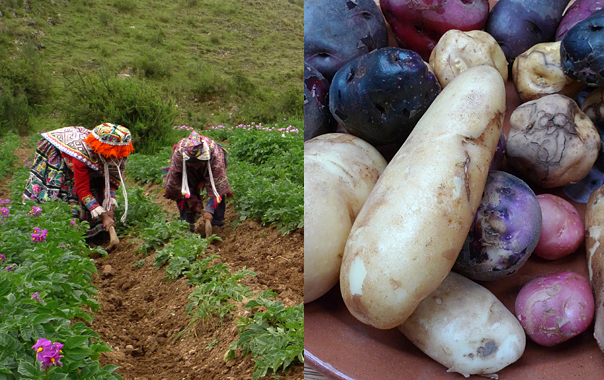This is the bride’s potato,” our guide says, holding up a fist-size tuber covered with tiny, warty lumps. In Incan times, young women were required to peel one of these potatoes before their wedding ceremonies to demonstrate their worthiness as wives. No records, he says with a laugh, were kept on how many passed the test.
The qhachun waguchi is one of 200 varieties on display in the visitors’ center at Peru’s Parque de la Papa, or Potato Park—a relatively new and little-known attraction near Cusco, the Spanish colonial city high in the Andes that serves as the gateway to Machu Picchu. The 22,000-acre potato preserve grows more than 1,300 varieties, revered for both their cultural significance and their practical uses.
Visitors (who can sign up for one-, three-, and five-day tours) meet with farmers, weavers, and cooks throughout their stay. And, of course, they eat: Potatoes are part of every meal here. On average, each of the indigenous residents of the park consumes 4.4 pounds of potatoes per day, or more than 1,600 pounds annually. Compare that to the average American, who eats just 131 pounds per year (yes, that includes French fries and potato chips).
When my sister and I visited the park in February, we had just one day, which began early with a stunning drive along winding roads past the Incan ruins at Pisac and panoramas of terraced fields of corn, flowers, and (of course) potatoes. Our first stop was the village of Sacaca, the heart of the park. In a tidy stucco building with a wall of colorful stained glass, our guide explained (in Quechuan, which was translated into Spanish, which was then translated into English) that local farmers grow 700 varieties of potatoes that are native to the area, plus hundreds more repatriated to the region by the International Center of the Potato, a high-tech gene bank in Lima.
Each potato, it seemed, had its own special or ceremonial use: There were potatoes to eat at baptisms; potatoes, like the bride potato, for weddings; and others for funerals. Potatoes like the red moro boli were high in antioxidants, while potatoes such as the ttalaco—a long, banana-shaped tuber—must be either soaked and steamed or made into a potato alcohol.
Back in the van, we took a hair-raising ride on twisty, unpaved roads bordered by sheer cliffs (and no guard rails), but all was made well when we arrived in the village of Pampallaqta. A local family greeted us with fresh leis, then led us across a stream to fields of purple- and white-flowering potato plants. Farmer Lino Mamani explained he was cultivating more than 400 kinds of potatoes in just one field. Some varieties grow everywhere; some can only be properly grown on the steep slopes above 13,000 feet. Increasingly, Mamani told us, farmers are experimenting at higher altitudes to combat climate change.
A third village, Chawaytire, is home to the eco-park’s all-organic restaurant. Papamanka, or “potato pot,” is housed in a brand new building with a large open kitchen; a wood stove; and a long wooden counter where purple, white, black, red, and yellow potatoes are displayed ceramic dishes. On the menu: cream of corn soup made with huacatay, a local herb sometimes called black mint; grilled alpaca meat with orange sauce; and potato pudding (made with potatoes, milk, sugar, and mint).
Papamanka is run by a women’s association established to preserve traditions and recipes; it keeps track of local lore about which potatoes promote digestion, which ones give you energy to work in the fields, and more. The women demonstrate a deep respect for these foods. When we asked director Celia Montalvo Acurio to cut open some of the potatoes so we could see the colors inside, she politely refused: To cut a potato without eating it would be an insult to pachamama, Mother Earth, and would bring bad luck.
Such beliefs, being part of the collective cultural knowledge in this region, are of great interest to scientists like Jiwan Palta, a University of Wisconsin horticulture professor who has spent his career developing the perfect potato for chips, French fries, and other processed foods.
Until recently, Palta says, the industry put a premium on large, shapely, sturdy tubers. Today, they want more nutritious ones. On his six visits to Potato Park, Palta has taken samples of heirloom varieties with high quantities of vitamins, proteins, and antioxidants. He’s also looked for characteristics that could help develop breeds that are resistant to diseases such as Late Blight, the fungus that caused the Great Famine in Ireland and still plagues Western varieties today. “Potato Park is unique,” says Palta: “There is nowhere else where they are trying on such a large, natural scale to preserve biodiversity.”
For more information on Potato Park, visit www.parquedelapapa.org. One-day tours are arranged by Cusco travel agency, Personal Travel Service, and cost $95 per person. 51-84-24502; pdp@andes.org.pe.

